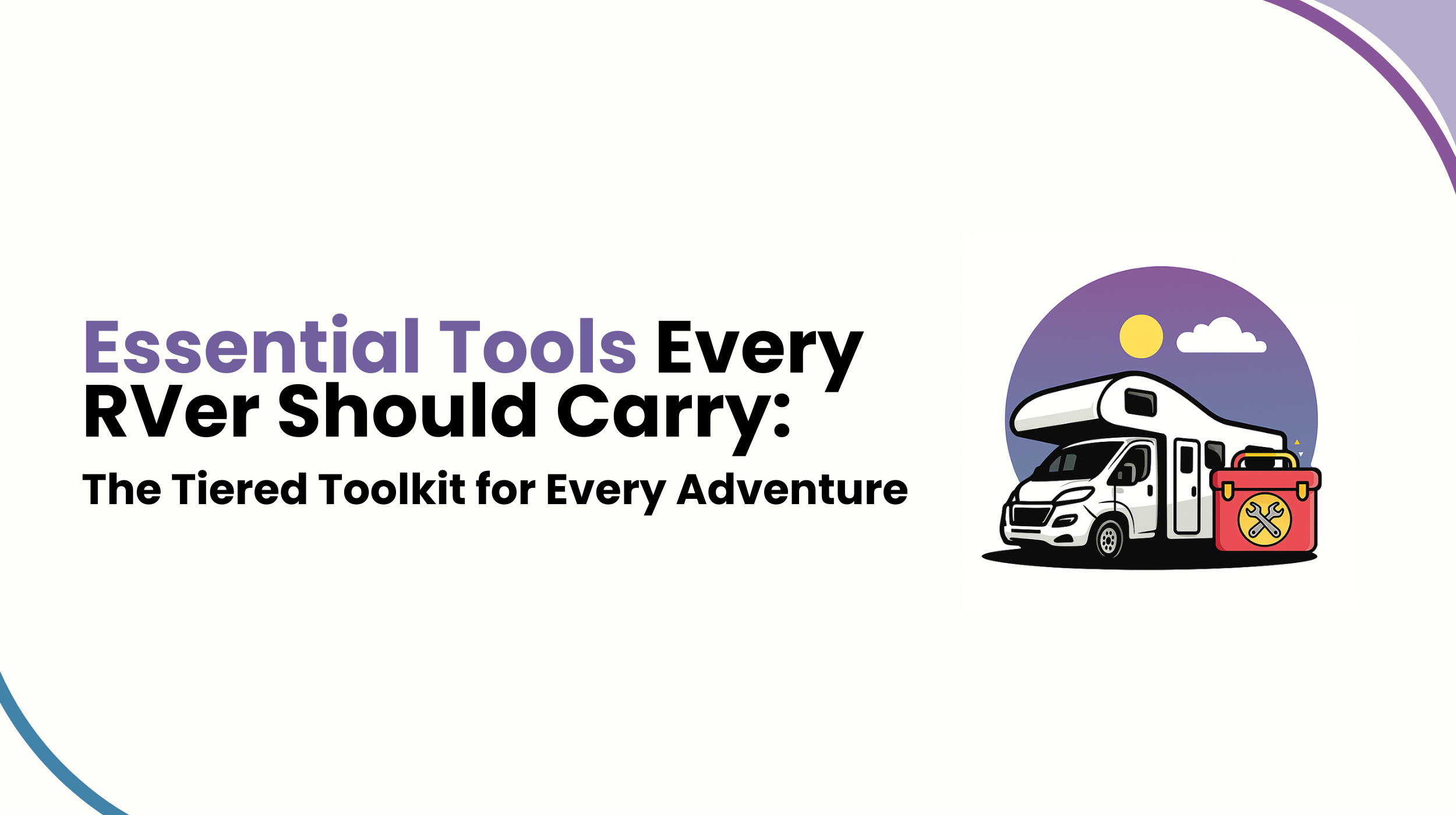RV travel offers a unique sense of freedom. You can chase sunsets along mountain passes or wake up next to a secluded lake with your home right beside you. However, this freedom comes with responsibilities. When your home is on wheels, it experiences wear and tear. RV life requires occasional maintenance, whether it’s a rattling cabinet, a faulty connection, or a blown fuse. When you are camping miles away from assistance, being self-sufficient isn’t just convenient; it’s crucial.
Benjamin Franklin once said, “By failing to prepare, you are preparing to fail.” That’s the core truth behind this guide. We’ve built the ultimate RV tool checklist using a tiered system that evolves with your experience level. Whether you’re a weekend adventurer or a full-time road warrior, this toolkit grows with you. Let’s explore what every RVer should carry, starting with the basics and building toward the gear seasoned pros use.
Tier 1: The Absolute Essentials Every RVer Must Carry
At the foundation of every RV toolkit is a core group of tools no RVer should leave home without. These are the non-negotiables, the must-haves that serve you whether you’re gone for a night or crossing state lines for weeks at a time.
A good multi-bit screwdriver is critical, and it should include a #2 square bit, also known as a Robertson bit, because many RV cabinets and panels are secured with this specific head. A basic pliers set should include needle-nose pliers for delicate work, standard pliers for gripping, and channel-lock pliers (also known as pump pliers) for larger fittings. An adjustable crescent wrench is essential for tightening hose fittings and bolts of various sizes. Additionally, a hammer or rubber mallet comes in handy for everything from securing stabilizer pads to knocking loose stubborn gear.
Before every drive, a reliable tire pressure gauge is a must. Keeping your tires at the correct PSI improves fuel efficiency and, more importantly, ensures your safety. Duct tape, especially the more durable Gorilla Tape, should always be within reach for quick fixes. Zip ties are also handy for temporarily securing loose wires, straps, or broken parts. Lighting is another priority. A high-quality flashlight or headlamp will serve you well in dark storage bays or during nighttime emergencies. To ensure your rig is level, a bubble level or RV-specific leveler is an inexpensive yet effective tool that protects your appliances and enhances comfort. Don’t forget a good pair of work gloves to protect your hands while handling hot equipment or greasy components.
Finally, carry an assortment of spare 12-volt fuses. These are commonly needed for everything from your water pump to your lighting system, and blowing one without a backup can quickly complicate your trip.
These tools cover many simple problems and ensure you’re equipped for the most common RV hiccups.
Tier 2: The Intermediate Kit for the Confident RVer
As you begin to travel more often or spend longer periods on the road, it’s important to adapt your toolkit to handle more complex repairs and proactive maintenance.
A cordless drill paired with a full set of drill bits is essential. It can save you hours of manual labor and helps with tasks such as removing paneling or tightening screws in hard-to-reach places. In addition, a socket and ratchet set, ideally in both standard and metric sizes, allows you to work on everything from furniture mounts to axle bolts. For wheel maintenance, a torque wrench ensures your lug nuts are tightened to the manufacturer’s specifications, which is a safety must.
Electrical issues are among the most common concerns for RVs, so having a digital multimeter is invaluable. This tool helps diagnose power problems, check battery voltages, and confirm that shore power is functioning properly. A caulking gun, especially when used with an RV-friendly sealant, is useful for resealing joints, windows, or roof seams while on the go. It’s also smart to connect a water pressure regulator when using campground hookups to protect your plumbing from high pressure, which could burst fittings or hoses.
A 12-volt portable air compressor or tire inflator allows you to quickly top off your RV or tow vehicle tires, which is critical for long-distance driving. A breaker bar can help loosen bolts that are too tight for your regular wrench, and a lithium jump starter provides peace of mind if your engine or house batteries die while boondocking. Lastly, a sturdy utility knife with replaceable blades is handy for cutting insulation, trimming vinyl, or opening packages.
This intermediate-level gear allows you to handle moderate repairs and keep your systems running efficiently without relying on roadside assistance.
Tier 3: The Pro’s Arsenal for Full-Timers and DIY Experts
For the full-time RVer or the experienced DIY enthusiast, your toolkit becomes a reflection of your independence. These tools are meant for serious repairs, upgrades, and customizations.
A bottle jack rated for your rig’s weight and a pair of sturdy jack stands are necessary if you ever need to lift the RV to change a tire or access undercarriage components. Many RV plumbing systems use PEX piping, so a pipe cutter and a set of crimp fittings are incredibly useful for water line repairs or upgrades.
If you frequently perform wheel or suspension work, a battery-powered impact wrench will save your arms and dramatically reduce the time needed for removal and installation. Electrical repairs and upgrades become much easier with a quality combination of wire strippers, cutters, and crimping tools. Vise grips are another pro-level essential, offering a reliable grip on rounded bolts or acting as a makeshift clamp.
For those venturing far from civilization, a portable fuel tank can serve as a backup power source for generators or support extended boondocking trips. When it comes to roof maintenance or even cleaning solar panels, a telescoping ladder allows you to reach high areas without requiring much storage space.
These tools are valuable investments in self-sufficiency and are perfect for those who consider the road as their home.
Beyond the Tools: Essential Supplies and Consumables Checklist
Even the most advanced toolkit is only half complete without the right supplies. These consumables allow you to perform effective, long-lasting repairs, such as sealing leaks, tightening fittings, or fixing electrical components.
In the adhesives and tape category, every RVer should carry standard duct, electrical, and Gorilla Tape. Super glue and epoxy are great for bonding broken parts, while roof seal patches like Eternabond are lifesavers for mid-trip roof damage.
Sealants and lubricants are also vital. Always have a tube of silicone or Dicor lap sealant on hand for exterior sealing, along with a supply of grease for wheel bearings, stabilizers, or trailer hitches. Slide-out lubricant helps reduce wear and noise, and a general-purpose lubricant like WD-40 keeps hinges and moving parts functioning smoothly.
Regarding electrical supplies, spare 12-volt fuses are a must, as are wire connectors and replacement bulbs for interior and exterior lights. Teflon tape is another essential for plumbing connections, and a small bin of assorted screws, nuts, washers, and bolts will serve you well during quick hardware fixes. Keep plenty of shop rags or microfiber towels for cleaning, wiping down tools, or mopping up leaks. And of course, don’t forget extra engine oil, coolant, washer fluid, and DEF fluid if your rig requires it.
Together, these supplies will help complete your mobile workshop and ensure you’re always prepared to address any issues that may arise.
Building Your Kit: Pre-Packaged Sets vs. DIY
One of the most common questions is: What’s the best tool kit for an RV? While there’s no universal answer, there are two main approaches: pre-packaged kits or building your own from scratch.
Pre-packaged toolkits are a great place to start. They offer convenience and value, especially for beginners, and often include a variety of screwdrivers, pliers, and wrenches in one compact case. The downside is that they can contain low-quality or unnecessary tools and often lack RV-specific items like a #2 Robertson bit. The Lippert RV Toolkit is a popular starting point for many RVers, while Apollo kits are a budget-friendly option. For those who prefer premium tools, Channellock offers high-durability selections.
Building your own kit allows you to choose only the tools you’ll use and select trusted brands known for durability and comfort. While this approach costs more and takes time to assemble, it results in a toolkit tailored to your rig and skill set. For most RVers, a hybrid approach is best, start with a quality base kit and add specialized tools as your needs evolve.
Smart Storage Solutions for Your RV Tool Kit
Storage is often an afterthought, but it is critical in protecting your tools and your RV. Tools that roll around or shift during transit can cause damage or become safety hazards.
Using modular or interlocking toolboxes helps you organize tools by category, such as plumbing, electrical, or mechanical. Soft-sided tool bags are great for essentials you use frequently and need to carry easily. For smaller items like bits and screwdrivers, magnetic strips mounted inside a cabinet or cargo door keep things secure and within reach.
It’s smart to keep your most critical tools, like a flashlight, tire gauge, and gloves, accessible in your tow vehicle or cockpit storage for quick roadside fixes. Always pay attention to how weight is distributed, especially in trailers or motorhomes, where uneven loads can affect handling. Don’t forget to secure your storage bins to prevent damage during sharp turns or bumpy roads.
Frequently Asked Questions
What are RV must-haves?
At a minimum, you should carry a surge protector to protect your electronics, a potable water hose, a sewer hose with fittings, leveling blocks or ramps, a basic toolkit with screwdrivers and pliers, a tire pressure gauge, and a flashlight or headlamp for nighttime needs.
What should I stock in my camper trailer?
Start with the absolute essentials mentioned in Tier 1, then add intermediate or pro-level tools depending on how often you travel and how confident you are with maintenance tasks. Always include consumables like tape, fuses, lubricants, and spare bulbs.
What is the best tool kit for a camper?
There’s no one-size-fits-all answer. Many RVers find success starting with a pre-packaged kit like the Lippert RV Toolkit, then customizing it over time. The key is to balance convenience, quality, and your specific needs.
Hit the Road with Confidence
When you’re out on the road, surrounded by open skies and endless highways, the last thing you want is to be stopped by a simple mechanical issue. But with the right tools onboard, you’ll never be at the mercy of circumstance.
A flat tire becomes a 30-minute fix, not a call to the tow truck. A leaky valve becomes a minor inconvenience, not a trip-ending problem. The more prepared you are, the more confident and free your RV experience becomes. So take the time to build your toolkit, stock your supplies, and hit the road knowing you’re ready for whatever comes your way.

